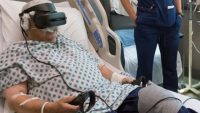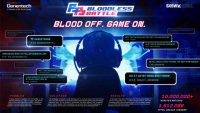CES: Case Studies on How Gaming Tech Can Improve Health
January 7, 2022
Much has been written on how gaming can be an incentive to change behavior. But can it also be used to clinically improve health outcomes? Lygeia Ricciardi, founder and chief executive of AdaRose — “a community of powerful women who are maximizing self care, health and wellness” — gathered executives at CES who said their companies have successfully used gaming to improve health for numerous use cases including pain reduction, aid in concentrating, lower drug reliance and more medical compliance as well as generally improved levels of well-being.
At Waya Health, president Dr. Joe Morgan provides a VR/AR/XR platform for patient care. Morgan described the Waya Health platform’s uses for procedural immersion and distraction; physical therapy and rehabilitation; patient education; and data collections and assessments.

“We also use extended reality for distributed group therapy so people across the country or world can join an experience,” he said. “It really enables therapists to have a much greater reach.”
Biotechnology company Genentech has products for hemophiliacs, explained marketing director of patient and digital experience Petra Szatmari. Most hemophiliacs are men, and the company was failing to reach the younger demographic. “We did know they like to game,” she said. “So in December 2020, we held a six-hour eSports event with Twitch to engage hemophilia patients during the pandemic.” It reached 1.6 million people who not only connected with Genentech but with each other, creating a community.
“This was a way to reach out to people who never reached out to us before,” she said.

At University of Michigan, Ramses Alcaide worked on new brain-computer interfaces (BCI). As founder of Neurable, Dr. Alcaide created cognitive measurement tools to ascertain when the brain was paying attention and when it was distracted. Neurable has now introduced Enten, headphones that incorporate BCI and help the user be more aware of when he is getting distracted; the headphones also prompt the user to take rests when needed.
“I’ve improved the time that I am not distracted up to 80 percent, from 50 percent before,” said Alcaide. “Learning how to balance rest and concentration is counterintuitive but you get continuous feedback with wearable technology.”

Ricciardi asked if they had measured the impact of their products. Morgan stated that, “the extended reality literature is full of different points of evidence with regards to reductions in pain.”
“We’ve managed to replicate a pretty clear, well researched signal for pain reduction,” he said. “We’ve seen most efficacy with anxiety in pilot efforts in moving to a digital therapeutic.”
Szatmari pointed out the importance of having built community. “From a marketing lens, our job is to get people to think about our product and nudge them to talk to somebody about it so they can make an informed choice,” she said, “They don’t listen to doctors much less manufacturers, but they will listen to each other.”
Alcaide agreed that community is important “from the point of view of neurotech education.” “Very few people understand what we do,” he said. “We have a Discord community where people can come and talk to us. Our company is community-built.”
For more on CES 2022:
CES Hashtag — #CES2022
CES Twitter Handle — @CES
CES Facebook Page — facebook.com/CES

No Comments Yet
You can be the first to comment!
Sorry, comments for this entry are closed at this time.